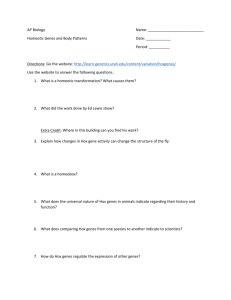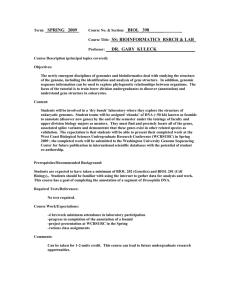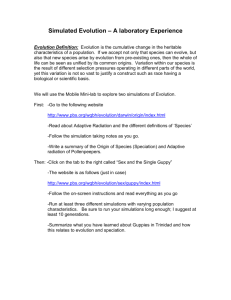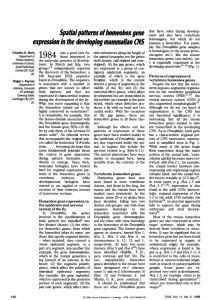Introduction to Animals Assignment revised 2009
advertisement
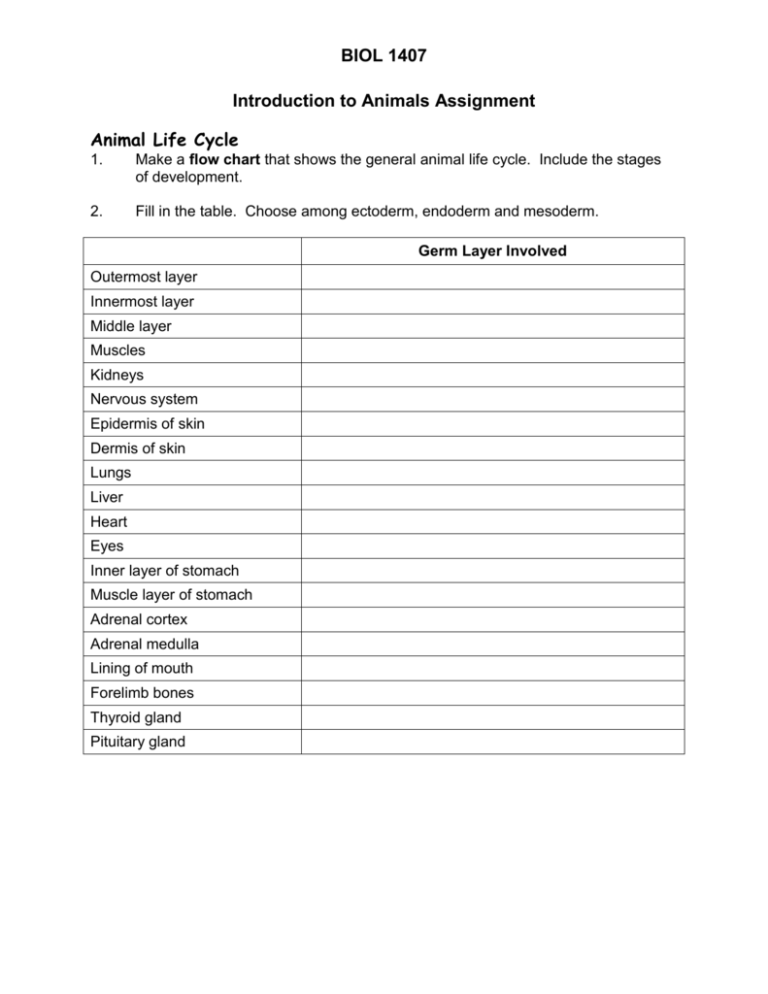
BIOL 1407 Introduction to Animals Assignment Animal Life Cycle 1. Make a flow chart that shows the general animal life cycle. Include the stages of development. 2. Fill in the table. Choose among ectoderm, endoderm and mesoderm. Germ Layer Involved Outermost layer Innermost layer Middle layer Muscles Kidneys Nervous system Epidermis of skin Dermis of skin Lungs Liver Heart Eyes Inner layer of stomach Muscle layer of stomach Adrenal cortex Adrenal medulla Lining of mouth Forelimb bones Thyroid gland Pituitary gland BIOL 1407 Comparative Embryology: The Vertebrate Body Go here: http://www.pbs.org/wgbh/evolution/library/04/2/pdf/l_042_03.pdf (Or Google "Comparative Embryology pbs") Print out the article. Answer these questions after reading the article and coloring the diagrams. 3. Compare the developmental stages of these five vertebrates. In particular, when are the embryos most similar? When do differences become apparent? Explain why the three mammals remain similar longer than the others. 4. What is the main reason for the small differences during cleavage? Animal Body Plans and Homeobox Genes Go here: http://www.pbs.org/wgbh/evolution/library/03/4/pdf/l_034_06.pdf Print out the article about Animal Body Plans and Homeobox Genes. Answer these questions after reading the article and coloring the diagrams. 5. Why did Geoffroy Saint-Hilaire think that vertebrates were upside-down invertebrates? 6. In Drosophila, what happens to the embryonic segments as the embryo develops into an adult. 7. What are homeoboxes and what do they do? 8. Compare Hox genes in vertebrates to homeobox genes in fruit flies. 9. Compare Hox genes in mice, humans and other mammals. 10. What has Hox gene research revealed about the evolution of animal eyes? Why is this significant? BIOL 1407 Genetic Tool Kit Go here: http://www.pbs.org/wgbh/evolution/library/03/4/l_034_04.html Play the video. Answer the following questions. 11. What happened when the eyeless gene in the fruit fly was removed and replaced with the mouse gene? What is the significance of this experiment? 12. Pay close attention to the section of the video that shows the body segments of a fly, fish, salamander, hummingbird and gorilla. Fill in the table, identifying which parts of each animal’s body comes from the colored segments. Animal Fly Fish Salamander Hummingbird Gorilla Blue (1st color) Green (2nd color) Yellow (3rd color) Dark Purple (last color) BIOL 1407 Further Explorations Animal Reproduction: The Wilder Side of Sex Go here: http://nationalzoo.si.edu/Publications/ZooGoer/2004/2/wildersideofsex.cfm (Or Google "Wilder Side of Sex") Read the article. 1. 2. 3. 4. 5. 6. 7. 8. 9. 10. Explain what happens when a male two-banded anemonefish meets another male. What are hermaphrodites? Give examples of animals that are hermaphrodites. Based on the Red Queen model, what advantage does sexual reproduction provide? Compare this to asexual reproduction. Explain why Daphnia switches from asexual reproduction to sexual reproduction. In alligators and painted turtles, what environmental factor determines whether a baby alligator or baby turtle becomes a male or a female? Explain the difference between a sequential and simultaneous hermaphrodite. Sequential hermaphrodites: a. Use the slipper limpet to illustrate sequential hermaphroditism. b. Differentiate between a protogynous and a protandrous hermaphrodite. Use the hamlets to illustrate simultaneous hermaphroditism. In protandrous fish, what is the relationship between body size and gender? Why? What is one hypothesis that explains why we do not see sex changes in birds and mammals?
